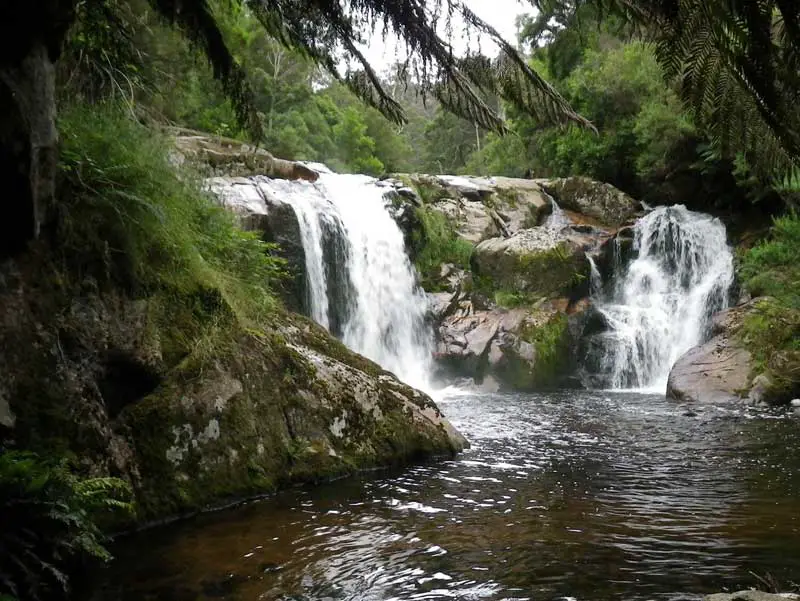Pyengana is a rural farming region with sites of such significant natural beauty and it is well worth leaving the highway that bypasses it, and stopping to savour a little of what it has to offer.
Where Is it?
27 west of St Helens, off Tasman Highway.
Pyengana is not nor has ever been a town, but a community that grew around the home of pioneering settlers George and Margaret Cotton who settled here in 1875 and raised a family of nine children at a property they called St Columba. The name recalls Saint Columba 521-597), a Gaelic Irish missionary monk who propagated Christianity among the Picts.

Things To See And Do

Pun in A Paddock
In 1880 a family with 15 children built a private homestead up the road from the Cottons. A decade later, a hotel license was granted for the property – known affectionately these days as The Pub in the Paddock. It has been continuously licensed ever since and visitors can experience hospitality of a bygone era with hearty meals and open fires. It has six rooms for accommodation and a tea room.

Pyengana Dairy
Up the road from The Pub in the Paddock is another Pyengana institution – Pyengana Dairy Company. Its renowned Clothbound Cheddar is produced by John Healey using the original method established by his great grandfather at the turn of the 20th century. With such a long history of production, Pyengana Clothbound Cheddar is one of Australia’s oldest specialist cheeses. Attached to the dairy is the Holy Cow Cafe, a wonderful place to do a little cheese tasting, or to stop and enjoy a light meal as the cows on the other side of the fence jostle for a spot on the laser-guided milking machines.
 St Columba Falls
St Columba Falls
Not far from Pyengana is St Columba Falls, one of Tasmania’s highest waterfalls, with water plunging 90m from the Mt Victoria foothills to the valley of the South George River. There is a delightful walk from the car park to the falls through one of the most captivating rainforests you will see in a long time. Halls Falls is a smaller, cascading waterfall, but its location in beautiful forest makes up for anything it may lack in size. The water that tumbles over these two falls is the reason the region became known as Pyengana. It is the Aboriginal word for “two rivers”. These days the two rivers are called North and South George. South George flows through the valley and spills over the top of St Columba Falls.


Surrounding Area

Lottah
The area around Pyengana had several tin mines such as the Anchor Tin Mine and Battery situated in the Pyengana Pass. Fifteen kilometres beyond Pyengana are the remnants of the mining village of Lottah where massive anchor stampers stand silently. These rusted tin crushing machines were driven by a waterwheel. At its height Lottah had 40 homes, but when the mine closed in the 1950s, the township was abandoned and all that remained was something resembling a moonscape. The site has since been reclaimed by Mother Nature.

Blue Tier Reserve
The Blue Tier Reserve is an exposed plateau with a rich mining and natural heritage. What makes the Blue Tier Forest Reserve so interesting is its long history in mining and forestry operations. The first Europeans came to this area after some miners who were working in the Mathinna goldfields discovered some rich tin deposits in some of the creeks in this area.
The news spread quickly and the area was settled in 1878 as a mining town. Back then the town was made up of a pub, two hotels, a blacksmith, butcher, three stores and a few residential cottages. The Blue Tier area also has a history in forestry operation. From 1945 to 1952 two sawmills were in operation with one run by a French family who milled celery top pine; while the Nichols mill focused on myrtle. There is a range of walks from a short 400m circuit, which is wheelchair friendly, to a 10.5km walk one-way to Weldborough for the more adventurous. More information >>
 Halls Falls
Halls Falls
Halls Falls in the north east, is located up near Blue Tier, and is the first attraction along the way to the Anchor Tin Mine Site and Blue Tier. There are also a number of picnic tables near the information booth, and some old mining equipment. The walk to the falls is only 30 minutes return, however if you want the full experience it is recommended that you dedicate about an hour and a half. The falls are one of the prettiest in Tasmania and are well worth leaving the main road to visit. What it lacks in sheer size it makes up for in quiet beauty.





